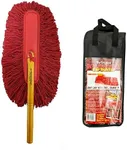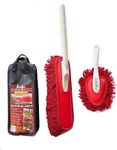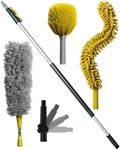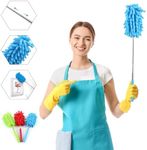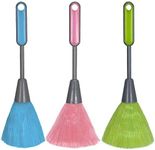Buying Guide for the Best Dusters
When choosing a duster, it's important to consider the type of surfaces you'll be cleaning, the frequency of use, and any specific cleaning needs you might have. Dusters come in various forms and materials, each designed to tackle different cleaning tasks effectively. Understanding the key specifications will help you select a duster that fits your cleaning routine and preferences.MaterialThe material of a duster determines its effectiveness and suitability for different surfaces. Common materials include microfiber, feather, lambswool, and synthetic fibers. Microfiber is excellent for trapping dust and is suitable for most surfaces, while feather dusters are gentle and ideal for delicate items. Lambswool is great for dusting wood surfaces, and synthetic fibers are often used for general-purpose dusting. Consider the surfaces you will be cleaning and choose a material that is gentle yet effective for those surfaces.
Handle LengthThe handle length of a duster affects its reach and ease of use. Short handles are suitable for close-up dusting tasks, such as cleaning shelves and countertops. Medium-length handles offer a balance between reach and control, making them versatile for various tasks. Long handles are ideal for reaching high places like ceiling fans and tall furniture. Consider the areas you need to clean and choose a handle length that allows you to reach those spots comfortably without straining.
WashabilityWashability refers to whether a duster can be cleaned and reused. Some dusters, like microfiber ones, are machine washable, making them a cost-effective and environmentally friendly option. Others, like disposable dusters, are designed for single use and need to be replaced frequently. If you prefer a low-maintenance option, choose a washable duster that can be easily cleaned and reused multiple times.
FlexibilityFlexibility in a duster refers to its ability to bend and conform to different shapes and surfaces. Flexible dusters can reach into tight spaces and around objects, making them ideal for intricate cleaning tasks. If you have a lot of nooks and crannies to clean, or if you need to dust around delicate items, a flexible duster will be a valuable tool in your cleaning arsenal.
Static ChargeSome dusters are designed to generate a static charge, which helps attract and hold dust particles. This feature is particularly useful for cleaning electronics and other surfaces where dust tends to cling. If you need to clean areas where dust is stubborn, consider a duster with static charge capabilities to make the task easier and more efficient.


